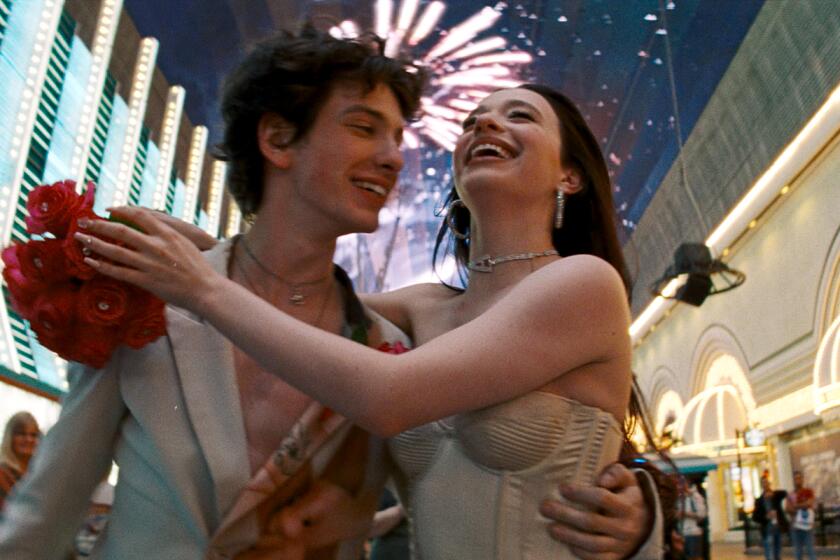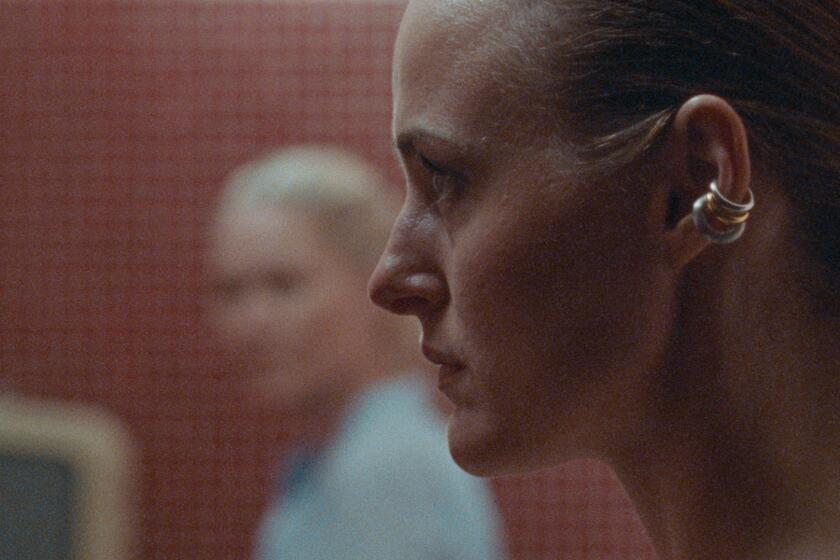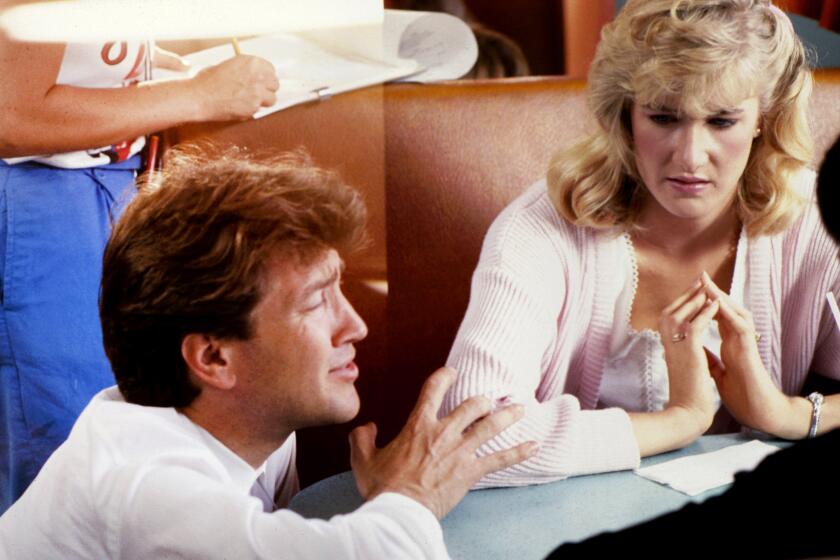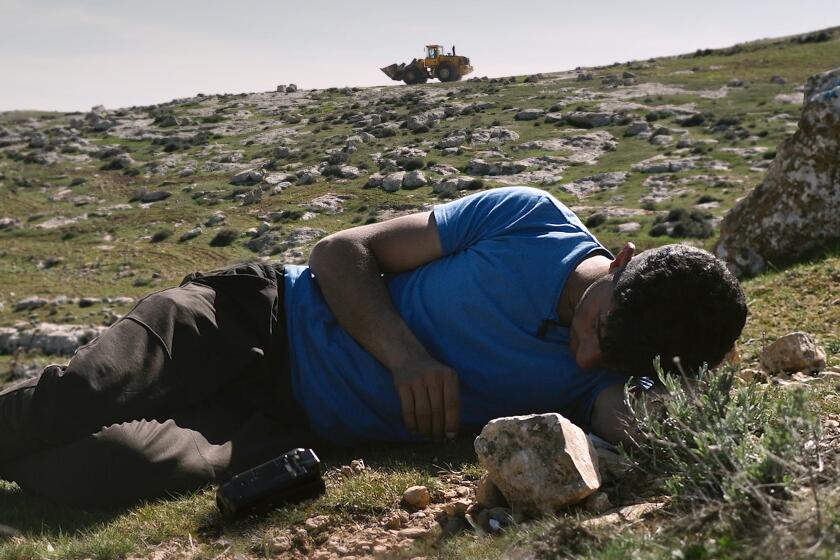Her Underwater Canvas
- Share via
One of Kathryn Bigelow’s teachers in art school instructed his students to find their “most productive weakness.”
That seemingly contradictory bit of advice remained lodged somewhere in a corner of her mind, and when she began directing movies, Bigelow discovered what her weakness was. “Withstanding pressure,” she says. So she set out to conquer it.
“I learned to treat the reality of constant pressure on a movie set abstractly, like it was a mental process,” she says.
It’s a character trait that was called on during the shooting of “K-19: The Widowmaker.” A $100-million Soviet submarine drama based on a true incident on a nuclear sub in 1961, the film took seven years to complete--but the shoot itself finished on time and on budget.
The credit for that, all agree, rests squarely on Bigelow’s shoulders. “It was a huge logistical undertaking,” says Harrison Ford, who stars as the sub’s Capt. Alexei Vostrikov. “But I don’t remember ever facing the feeling of chaos. Directors have to be able to think on their feet when the time isn’t there, the light isn’t there, when the capacity of an actor to perform isn’t there--and they have to find a way to make it work anyway. Kathryn never would have survived if she hadn’t been able to do that.”
But it’s the 50-year-old director’s art school background, rather than her newfound grace under pressure, that comes up repeatedly in an interview. At other times, she compares the work of her B-movie heroes--directors Samuel Fuller and Anthony Mann--to the “pure expression” of Jackson Pollock and William de Kooning. She explains her ability to flout conventions about women directing action movies by saying her instincts were honed during her early years as an artist.
“In painting, there are no preconceived notions of what’s possible. You’re always starting with a blank canvas,” she says. “And that’s what’s given me strength.”
“K-19” is based on the maiden, disaster-prone voyage of a Soviet nuclear submarine in 1961. The threat of a nuclear meltdown aboard the sub is a harrowing, little-known chapter in the history of the Cold War. It was only through the clear thinking of the sub’s captain and the heroism of its crew that a disaster of global significance was averted.
Suppressed for three decades, the story of the K-19 came to light in the early ‘90s after the demise of the Soviet Union. Rights to the story were immediately scooped up by National Geographic’s film division after executives there saw a British-made documentary on the subject, says Christine Whitaker, the company’s executive vice president of production.
A story that focuses on Russian submariners and told from their point of view may have seemed an odd choice for an English-language feature film, but “one of the primary reasons we were attracted to it,” Whitaker says, “is that National Geographic has been turning the camera on other cultures for 115 years. It fit in with our mission” of expanding into feature films.
Whitaker thought of Bigelow, who had made her name with fast-paced action stories, including the biker-horror film “Near Dark” (1987); the psychological cop thriller “Blue Steel” (1990), starring Jamie Lee Curtis; the action adventure “Point Break” (1991) with Keanu Reeves; and the apocalyptic sci-fi drama “Strange Days” (1995) with Ralph Fiennes and Angela Bassett (her former husband, James Cameron, was a producer and co-writer on that).
“From our first meeting,” Whitaker says, Bigelow “understood the humanity behind the story. It wasn’t just a submarine thriller. It was about men rising above their circumstances and their politics to do something for the greater good.”
The opportunity to illuminate this obscure chapter in history was as much a learning experience for Bigelow as she hopes it will be for the audience. “I had no idea of the Russian psychology at the time. For me, they were horrible people who were going to push a button and destroy the world.
“This was such a great opportunity to put a human face to some incredibly brave individuals without whom our lives would have been changed.”
Bigelow developed the script with playwright Christopher Kyle for the British production company Working Title. That was the easy part. The project was stalled when Universal Pictures announced another submarine drama, “U-571,” released in 2000, and Bigelow went off to make a more personal independent project, “The Weight of Water,” starring Sean Penn and Elizabeth Hurley; after several delays, “The Weight of Water” is to be released in November.
After Working Title put “K-19” in turnaround about three years ago, it was shopped to a number of companies. The overseas independent company Intermedia agreed to finance the movie that, by this time, also had an expensive star, Ford, attached. During production, Intermedia contracted with Paramount Pictures to distribute the film in the U.S. and certain key countries abroad.
Just as the deal was finally set, a competing script materialized, which led to litigation that was eventually settled, according to Intermedia principal Nigel Sinclair. He is legally proscribed from discussing the terms of the settlement.
While the film was in pre-production, another real-life submarine disaster occurred. In August 2000, the Russian nuclear sub Kursk was lost and all 118 men aboard perished. After debating the propriety of releasing “K-19” at that juncture, Bigelow says, she decided to proceed.
The Kursk disaster put to rest any doubts that American audiences would respond to a story about an ill-fated Russian submarine. “Sadly, the horrendous disaster of the Kursk had the entire world spellbound, and the myopic idea that Americans only want to see stories about Americans dissolved completely,” she says.
There were additional pressures, the most daunting of which was that “we were working against a potential SAG strike and there was no wiggle room in terms of schedule,” Whitaker says. “We were shooting in three different countries and the dates were not fungible.”
In addition, says Sinclair, all but 22 days of the 16-week shoot were on water, an element that has wreaked havoc with the best-laid plans (and budgets) of moviemakers in the past. (“Waterworld” being the most calamitous example).
“I flew up to Canada for the first day of the water shoot,” Sinclair recalls. “There were 28 vessels, including two subs, two frigates, 18 to 20 support boats and a naval helicopter. It was easy to imagine a shoot like this going $20 million over budget. But we didn’t.”
Bigelow was raised in the Northern California city of San Carlos, which she calls “a good place to grow up.” As the only child of an English teacher mother and a father who managed a paint factory, she says she has been interested in art “for as long as I can remember. Though I had friends, I was an introvert and I expressed myself through art. Next thing I know, I’m at the San Francisco Art Institute and my teacher has submitted my work to the Whitney Museum’s independent study program.”
She was accepted into the program and moved to New York, where “I was given a studio for a year, at the end of which people like Susan Sontag came down and commented on my work,” Bigelow says.
Soon thereafter, however, she switched to film, enrolling at Columbia University. The reason, she explains, is that “painting is a bit elitist, while film crosses culture and class. It’s a populist medium that people can access in different ways. That’s difficult to do with a painting. To understand it requires a background. In art, context is everything.”
To anyone familiar with her body of work, Bigelow’s love of B-movies informs her style. “Near Dark” pays homage to such time-honored B-grade genres as the biker movie, the western and the horror film. “Blue Steel,” “Point Break” and even the more epic “Strange Days” are alive with a pulp sensibility. If “K-19” seems incongruous in this mix, she cites B-movie auteur Fuller’s 1954 submarine drama “Hell and High Water,” with its masterful camera moves in confined spaces.
“I love B-movies, like Anthony Mann’s ‘Crime Wave,’ because the creative muscle [of the filmmaker] hasn’t been put through the Hollywood homogenization machine,” she says. “They are pure expression like the works of Jackson Pollock or Willem de Kooning. There is a wildly chaotic rawness to [B-movies]. And they’re not self-important.”
From the preparation of “K-19” through its post-production, she relied heavily on her gut and not her brain. “I work so instinctively that I can’t be cerebral too early. It would ruin the spontaneity.” Over-thinking a film’s themes can compromise the drama, and Bigelow says she chose to allow the film to emerge through the accrual of detail, not dissimilar to the way an artist layers paint on a blank canvas.
Besides, on a project of this magnitude, there was no time for musing or second-guessing. The meticulous construction of the “K-19” sets was an intense experience. She catches herself, and laughs, “Oh yeah, as you can see, I really got into it.”
The sets were built using photographic studies of the sub’s interiors and, just before construction began, the production secured access to the blueprint of the K-19.
“We worked on getting that over a period of years through the process of declassification. As you can imagine, given the nature of the history between the military industrial complexes of the U.S. and the USSR and the fact that this was a nuclear submarine, it wasn’t something they handed out like a vacation brochure.”
The production bought a Russian nuclear sub built two or three years after the K-19 and cannibalized the interiors. “Because we were able to use all original equipment, we began to understand the architecture of submarines, which are ergonomically designed so that the instruments are all within arm’s distance.”
The cast and crew underwent two weeks of “boot camp” training with Russian submariners so they understood their duties aboard the K-19 as well as the demands and procedures of daily life under the sea.
Built to scale, the sets were “extremely, extremely tight,” Bigelow says, “no space, no oxygen. After spending months in these incredibly microscopic chambers, you felt you had a legitimate impression of what it would be like to be a submariner. It created a verisimilitude that, I think, was necessary for the piece.”
The thought of Bigelow, who is 5 feet 11, and the film’s two leading men, Ford and Liam Neeson, who are even taller, crammed into a small set with a camera and crew produces a rather claustrophobic image. “Claustrophobia is not an option for submariners,” says Ford, although he admits “it was a bit of a challenge to find different ways to keep the visual environment alive. One of Kathryn’s biggest talents is visualization, and she was very collaborative with the actors in letting us find motivations for the kinds of movement that reinforced the reality of the space.”
Bigelow says she devoted as much attention to the characters’ inner lives as to their physical environment, interviewing survivors of the K-19 and Vostrikov’s widow. “Her ability to accept what I wanted to do and let me in emotionally was extraordinary, especially given that I represent the Hollywood community, which has usually portrayed the Soviets as either sinister or laughable.”
Transcending those stereotypes, she continues, was essential to the success of her undertaking. “At the end of the day, in order for the story to have resonance, you have to care about the characters,” even if they were, politically, our polar opposites. Her sincerest hope is that American audiences will come away from the film thinking, “They were the enemy and I desperately wanted them to live.”
*
Richard Natale is a regular contributor to Calendar.
More to Read
Only good movies
Get the Indie Focus newsletter, Mark Olsen's weekly guide to the world of cinema.
You may occasionally receive promotional content from the Los Angeles Times.










